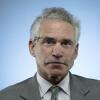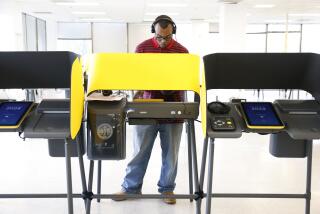On Politics: Here’s why California’s early 2020 primary is destined to pick the next president. (Nah, not really)
Today we answer questions.
Woo-hoo! Now that Gov. Jerry Brown has signed the bill, it looks like California is moving up its 2020 presidential primary. Finally!
Uh.
No more watching from the sidelines as small-fry states like Iowa and New Hampshire throw their weight around.
Um.
I’m already fluffing pillows and prepping the guestroom for all the 2020 hopefuls who’ll be camped out.
Er.
What? You don’t seem too excited.
Look, it would be great if California voted in a truly meaningful presidential primary. It’s been about 50 years since that happened. But it’s about as likely in 2020 as President Trump dumping Vice President Pence and running for reelection on a unity ticket with Hillary Clinton.
How can that be?
Lots of reasons, both political and practical.
Do tell.
First off, this will be the sixth time since 1992 the state has moved its presidential primary. It’s bounced from June, March, February and back again. And every time California pushed its primary ahead, other states moved up as well, to minimize California’s impact and make sure they weren’t big-footed.
You can be sure the same thing will happen in 2020 when California elbows its way up again.
But California has the sixth-largest economy in the world and 40 million residents, more than Canada. We deserve more clout. Anyone can see that.
And, boy, do people in other states love hearing over and over how big and important California is. Especially when they’re waist-deep in snow, watching on TV as the weather map shows L.A. and San Diego basking in 60-degree winter weather.
Don’t underestimate the depth of anti-California sentiment — never mind all those politicians who parachute into the state and make off with armloads of cash. Congress once saw fit to snub UC Berkeley and stick an earthquake research center in Buffalo, N.Y., which is not exactly a hotbed of seismic activity.
Come now. Surely candidates will see the benefit of investing significant time and effort in California. We’re big! We’re important! We’re the future!
Hmm. Set aside your California chauvinism for a moment and go easy on the exclamation marks, if you would.
Retail politicking, which is to say the kind of person-to-person campaigning that is the norm in Iowa and New Hampshire, is impossible in a state that, placed on a map, stretches from Maine to South Carolina. The only way to get known in California is through television advertising, which is obscenely expensive.
So a candidate could spend many millions of dollars trying to gain a toehold in the state. Or they can spend a fraction of that and focus on a more manageable state like Iowa, New Hampshire or even next-door Nevada, using a strong performance there to catapult into California and the rest of the primaries and caucuses.
That breakthrough strategy has worked repeatedly, starting with Jimmy Carter in 1976, which explains why so many candidates stake their hopes on Iowa or New Hampshire, the two earliest-voting states. In fact, bypassing the initial contests and trying to vault into contention with a big win down the road has never worked for a candidate of either party.
Yes, but California has by far the largest cache of delegates. That’s a pretty big enticement to compete!
Perhaps for Republicans — assuming they ignore that basic cost-benefit analysis and the history of failed candidates skipping Iowa and New Hampshire. The GOP awards its delegates on a winner-take-all basis, meaning a pretty hefty payout.
But it’s different for Democrats. Being the Kum-bay-ya party, making sure everyone feels wanted and good about themselves, they award their delegates on a proportional basis. So even if a candidate wins California, they won’t necessarily walk off with a substantially larger haul than the second-place finisher.
In 2008 and 2016, for instance, Hillary Clinton beat Barack Obama and Bernie Sanders by a handy 8 percentage points. But she only netted 38 more delegates than Obama and 33 more than Sanders. Now do the math: Does it make sense to spend so many millions of dollars campaigning in California to eke out a few dozen more delegates than the runner-up?
Maybe not.
Hey, you might have a future as a political strategist. Or perhaps running for president yourself.
Well at least an early California primary could give a big boost to a home-grown candidate, say U.S. Sen. Kamala Harris or Los Angeles Mayor Eric Garcetti, should either choose to run.
Not necessarily. In 1980, Gov. Jerry Brown finished a distant third in the California primary, behind then-President Carter and Massachusetts Sen. Edward M. Kennedy. In 1992, as the state’s former governor, Brown finished second behind Arkansas Gov. Bill Clinton.
Oh.
The lesson being if a candidate wants to win California, it helps to notch a few victories somewhere else, to show viability as a White House contender. Otherwise voters aren’t likely to waste their ballot, regardless of a presidential hopeful’s home address.
Sigh. So I guess that means California will be pretty much on the sidelines in 2020, again.
Most likely. But don’t be so glum. You can always travel to Iowa or New Hampshire to see the presidential candidates up close and get a sense of what a truly competitive nominating contest feels like. They can be lovely in the winter.
Just don’t forget your snow boots and long johns.
@markzbarabak on Twitter
ALSO
Strange but true: Praise in lefty San Francisco for Pelosi and Trump — gasp — working together
Trump called him ‘my African American.’ But he condemns the president’s treatment of black America
Adam Schiff, President Trump and the serendipity of slander
More to Read
Get the L.A. Times Politics newsletter
Deeply reported insights into legislation, politics and policy from Sacramento, Washington and beyond. In your inbox three times per week.
You may occasionally receive promotional content from the Los Angeles Times.







